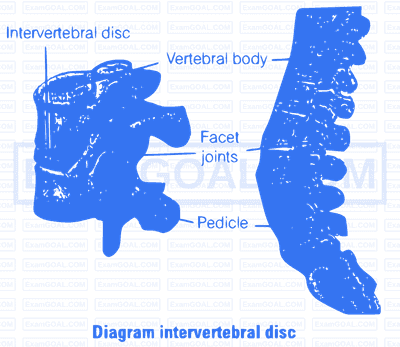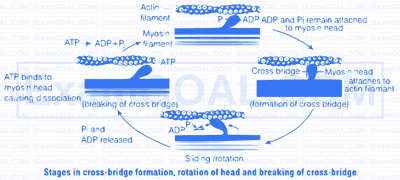Pectoral girdle Each half of the pectoral girdle consist of a clavicle and a scapula. The dorsal flat, triangular body of scapula has a slightly elevated ridge called the spine that, projects a flat expanded process called the acromion and the clavicle articulating with it.
Below the acromion their is a depression called the glenoid cavity which articulates with the head of the humerous to form the shoulder joint. Pelvic girdle consist of two coxal bones. each formed by the fusion of three bones, ilium, ischium and pubis. It articulates with femur through a cavity called acetabulum forming thigh joint.
For the muscle fibre to contract, the binding site on thin filaments must be uncovered. This occurs when $\mathrm{Ca}^{2+}$ bind to another set of regulatory proteins, called troponin complex which control the position of tropomyosin on the thin filament.
The calcium binding rearranges the tropomyosin, troponin complex, exposing the myosin-binding sites on the thin filament. When $\mathrm{Ca}^{2+}$ is present in the cytosol, the thin and thick filament slide part each other resulting in muscle contraction.
Similarly, when the $\mathrm{Ca}^{2+}$ concentration falls, the binding sites get covered and contraction stops. In case of tetany there occur low calcium levels in body fluid due to diminished function of parathyroid gland. This gland is mainly involved in the secretion of parathyroid hormone which is associated in regulating calcium levels in blood. Tetany results in periodic painful muscular spasm (wild contraction) and tremors.
Slipped disc is a medical condition in which spine is affected due to wear and tear in the outer fibrous ring (anulus fibrosus) of an intervertebral disc, allowing the soft, central portion to bulge out beyond the damaged outer rings.
These intervertebral disc are present between the bodies of adjacent vertebrae from the second cervical vertebra to the sacrum. This discs form strong joints that permit various movements of vertebral column and absorbs vertical shock.

The cause of slip disc can be due to general wear and tear of intervertebral disc during performing various jobs, that require constant sitting and squatting. The slipped disc or herniation occurs in two regions of body, i.e., cervical disc and lumber disc.
Slip disc in lower back lumber disc, lead to sharp pain in one part of leg due to sciatica, (disturbance in sciatic nerve), hip and cause numbness in other lower parts of the body.
Slip disc in neck region (cervical disc) leads to pain while moving neck near or over the shoulder bone or pain occurs while moving forearm, or fingers. It also causes numbness in shoulder, elbow, forearm and finger area. Hence, slipped disc affect the upper and lower body parts, thus, influencing life style and health.
Sliding filament theory
This theory is applicable to smooth, cardiac and skeletal muscles. The essential features of this theory are as follows
(i) During muscle contraction, thin myofilaments slide inward towards the H-zone.
(ii) The sarcomere, the basic unit of muscle contraction, shortens, without changing the length of thin and thick myofilaments.
(iii) The cross-bridge of the thick myofilaments connect with the portions of actin of the thin myofilaments. These cross-bridge move on the surface of the thin myofilaments, resulting in the sliding of thin and thick myofilaments over each other.
(iv) The length of the thick and thin myofilaments do not change during muscle contraction.
(v) A muscle fibre maintains a resting potential under resting conditions just like a nerve fibre. As soon as a nerve impulse reaches the terminal end of the axon, small sacs called synaptic vesicles fuse with the axon membrane and release a chemical transmitter,called acetylcholine.
It diffuses across the synaptic cleft (the space between the axon membrane and the motor end plate) and binds to the receptor sites of the motor end plate.
(vi) As soon as depolarisation of the motor end plate reaches a certain level, it creates an action potential. After this, an enzyme cholinesterase present along with the receptor sites for acetylcholine breaks down acetylcholine into acetate and choline.
A portion of the choline diffuses back to the axon and is reused to synthesise more acetylcholine for the transmission of subsequent impulses.
(vii) Calcium plays a key regulatory role in muscle contraction. The $\mathrm{Ca}^{+}$ions bind to troponin causing a change in its shape and position. This in turn alters the shape and position of tropomyosin.
This shift exposes the active sites on the F-actin molecules and myosin cross-bridges are then able to bind to these active sites.
(viii) The head of each myosin molecule contains an enzyme myosin ATPase. In the presence of myosin ATPase, $\mathrm{Ca}^{2+}$ and $\mathrm{Mg}^{2+}$ ions, ATP breaks down into ADP and inorganic phosphate as

(ix) Energy from ATP causes energised myosin cross-bridges to bind to actin. The energised cross-bridge move, causing the thin myofilaments to slide along the thick myofilaments. This movement is like the movement of the oars of a boat.
(x) As stated earlier in theory, there is no shortening of thin and thick myofilaments. However, the sarcomere shortens, because of the sliding of the thin myofilaments produced by cross-bridge movements. The H-zone and I-band shorten, but the width of the A-band remains constant.
How does a muscle shorten during its contraction and return to its original form during relaxation?
Formation of cross-bridge between the actin and myosin filament help muscle to contract. (i) An ATP molecule joins the active site on myosin head of myosin myofilament. These heads contains an enzyme, myosin ATPase that along with $\mathrm{Ca}^{2+}$ and $\mathrm{Mg}^{2+}$ ions catalyses the breakdown of ATP. $$ \text { ATP } \xrightarrow[\mathrm{Ca}^{2+} \mathrm{Mg}^{2+}]{\text { Myosin ATPase }} \mathrm{ADP}+\mathrm{P}_j+\text { Energy } $$ (ii) The energy is transferred to myosin head which energises and straightens to join an active site on actin myofilament, forming a cross-bridge.

(iii) The energised cross-bridges move, causing the attached actin filaments to move towards the centre of A-band. The Z-line is also pulled inwards causing shortening of sarcomere, i.e., contraction. It is clear from the above explanation that during contraction A-bands retain the length, while I-bands get reduced.
(iv) The myosin head releases ADP and Pi, relaxes to its low energy state. The head detaches from actin myofilaments when new ATP molecule joins it and cross-bridge are broken.
(v) In repeating cycle, the free head cleaves the new ATP. The cycles of cross-bridge formation and breakage is repeated causing further sliding.

(vi) Muscle relaxation occurs after contraction when the calcium ions are pumped back to the sarcoplasmic cisternae, thus, blocking the active sites on actin myofilaments. The Z-line returns to original position, i.e., relaxation.